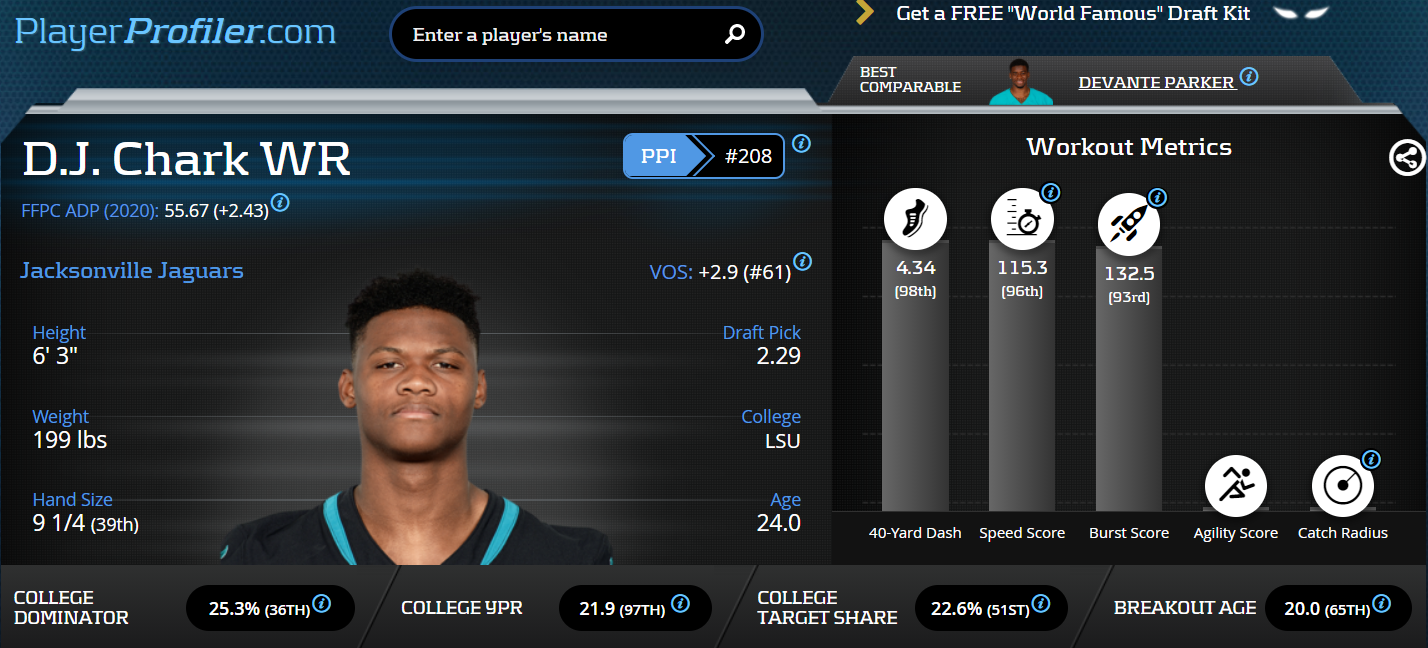Winning your fantasy football league requires selecting players that will vastly outperform their average draft position. It really is that simple, just ask the players who drafted Chris Godwin and Lamar Jackson last season. The fourth round of redraft leagues currently contain a bevy wide receivers who all have the potential to outperform their ADPs. Nailing this portion of the draft will be crucial to winning your league. One of the ways to successfully navigate this round is to draft D.J. Chark. If you need more convincing, allow PlayerProfiler’s advanced stats and metrics to help build his case.
D.J. Chark is for Real
Entering last season, D.J. Chark appeared to be an early round bust for the Jaguars. The 2018 second round pick sparsely saw the field, amassing a 42.7-percent (No. 140 among qualified wide receivers) Snap Share and seeing only 32 (No. 114) targets. However, Chark became the focal point of the Jaguars passing attack in 2019. He led the team with 117 (No. 20) targets en route to a breakout campaign, corralling 73 (No. 19) receptions for 1,008 (No. 24) yards and eight (No. 8) touchdowns. Overall, Chark finished with a 14.9 (No. 19) Fantasy Points per Game average.
Breakout or Fakeout?
D.J. Chark‘s sudden spike in production and lackluster prospect profile may make fantasy players leery of the sustainability of his success. However, his sudden spike in productivity is more likely a harbinger of things to come as opposed to a flash in the pan. As Rich Hribar explained earlier this offseason, Chark is in rare and dignified company.
The list of WRs since 2000 that have had larger spikes in 2nd year receiving yardage from their rookie seasons than what D.J. Chark had last year….
Alshon Jeffery
Brandon Marshall
Antonio Brown
Steve Breaston
Allen Robinson
Josh Gordon
Chad Johnsonhttps://t.co/uA6hsNVeUx— Rich Hribar (@LordReebs) August 2, 2020
With only Steve Breaston serving as the lone miss among a sea of former fantasy WR1s, it’s safe to say that Chark’s second year breakout is of little concern. This list not convincing? For fantasy football players concerned that last year was a too small sample size, zooming out and contextualizing Chark’s prospect profile should allay these concerns.
A Deceiving College Dominator
D.J. Chark entered the league profiling as a field-stretching wide receiver. This was the role he played in college, averaging 21.9 (97th-percentile) yards per reception. At 6-3 and 199-pounds, Chark ran a 4.34 (98th-percentile) 40-Yard Dash. This equates to an elite 115.3 (96th-percentile) Speed Score. Further, his 132.5 (93rd-percentile) Burst Score, adds additional evidence that he is an elite level athlete. Essentially, Chark’s athleticism profiles him as a Tyreek Hill-type, in a typical X-receiver body.
The only real concern about Chark entering the league was his paltry 25.3-percent (36th-percentile) College Dominator Rating. However, LSU’s run-heavy approach and Chark’s usage within that offense make this a less damming metric to his profile. During his college tenure, LSU averaged almost 43 rushing attempts per game compared to only 23 passing attempts.
Check out D.J. Chark’s 2020 Projection on PlayerProfiler’s “World Famous” Draft Kit:
While he failed to record a reception his first two seasons as a Tiger and primarily played behind Malachi Dupre until Dupre graduated, Chark was clearly the more dynamic player. He scored at least one rushing touchdown in each of his last three college seasons. While Dupre registered slightly more receiving yards in 2016, Chark’s breakout year, Chark finished with only five fewer total yards from scrimmage despite registering 15 fewer receptions. The reason behind this was Chark’s usage in the run game which, considering LSU’s offensive approach, was arguably more meaningful for the offense.
2020 Season Outlook
With ample evidence that D.J. Chark‘s 2019 breakout was for real, he will look to build on his sophomore season success this year. His team situation, and a developing rapport with second year quarterback Gardner Minshew, are the main reasons why Chark as overall WR1 upside in fantasy football leagues.
In the 14 games Minshew started last season, Chark averaged 14.2 Fantasy Points per Game. This helped placed him in the top 24 wide receivers in FPPG by season’s end. His success with Minshew was largely predicated by the rookie quarterback’s uncanny ability to connect on deep passes. Minshew’s 45.1-percent Deep Ball Completion Percentage was top five at the position. Assuming he is able to maintain this level of deep ball efficiency, Chark is an unquestioned WR2 with week-winning ability.
https://www.youtube.com/watch?v=tzX4Ws-Vbkk&ab_channel=ThePodfather
Minshew will likely have to take even more deep shots this season, with the Jaguars projected to face many negative Game Scripts thanks to an exodus of defensive talent. Further, the departure of former first round running back Leonard Fournette signals that the team will rely heavily upon the passing game. Finally, new offensive coordinator Jay Gruden plans to employ a scheme heavily reliant on play-action. An area where Minshew excelled in 2019, evidenced by a 71.6-percent (No. 6) Play-Action Completion Percentage in 2019.
Overall, Chark does not need many additional things to happen in 2020 for him to produce as a WR1 in fantasy. He is auto-selection at his current 55.06 FFPC ADP, and has the upside to finish as the overall fantasy WR1 in 2020.










